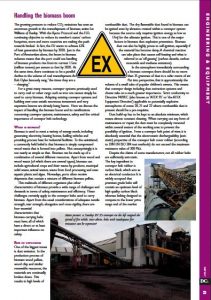May 2017 Dry Cargo International
Handling the biomass boom
The growing pressure to reduce CO2 emissions has seen enormous growth in the transshipment of biomass, writes Les Williams of Dunlop. With the Kyoto Protocol and the EU’s continuing objective to reduce its member’s states’ carbon footprints, more and more countries are making the push towards biofuel. In fact, the EU wants to achieve 63% of heat generation by biomass by 2020. Just in the Port of Amsterdam alone, the boom in biomass volumes means that the port could see the handling of biomass products rise from its current 1.5mt (million tonnes) per annum to 6mt by 2020. At the same time, there continues to be a parallel decline in the volume of coal transshipment. As Bob Dylan famously sang, “the times they are a – changing.” For a great many reasons, conveyor systems previously used to carry coal or other cargo such as iron ore cannot simply be used to carry biomass. Adapting existing conveyor systems and
building new ones entails enormous investment and very expensive lessons are already being learned. Here we discuss the impact of handling the biomass boom and its ramifications concerning conveyor systems, maintenance, safety and the critical importance of conveyor belt technology.
WHAT IS BIOMASS?
Biomass is used to meet a variety of energy needs, including generating electricity, heating homes, fuelling vehicles and providing process heat for industrial facilities. To the uninitiated,
a commonly held belief is that biomass is simply compressed wood waste that is formed into pellets…
Download the full article below:

